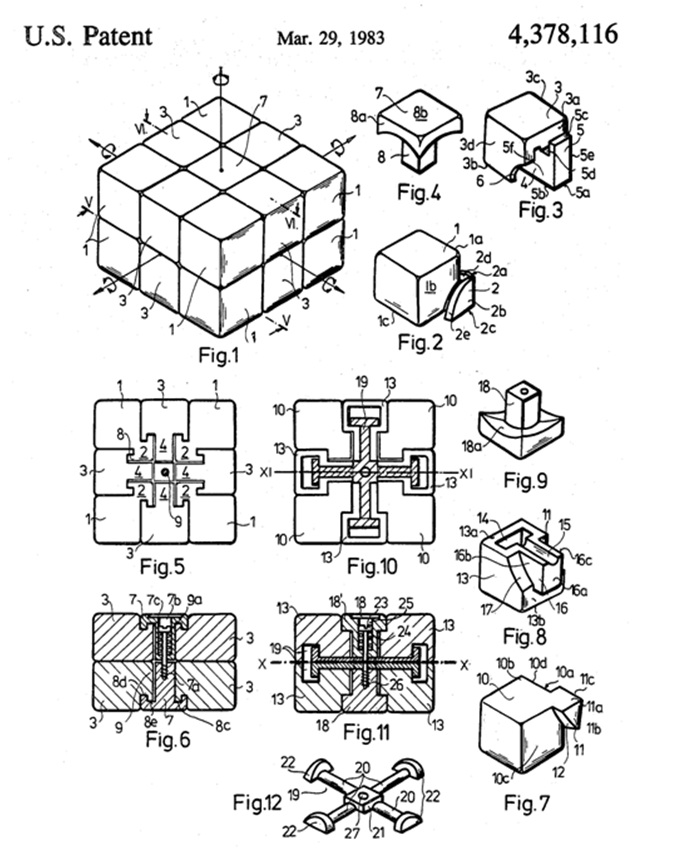Patent drawings or illustrations in patent applications are the visual form of Patent description or Invention; they aid in understanding the invention clearly. They may include illustration of embodiments, stages, flow charts, chemical equations, several views, reference numbers and photographs (in some cases) of the invention.
The drawings may be required by the law to be in a particular form, and the requirements may vary depending on the jurisdiction. The drawings must preferably show every feature of the invention as specified in the claims. Although it may be noted that inclusion of drawings in a patent application is not mandatory.
Importance’s of Patent Drawings
While including drawings is not mandatory, one may be able to appreciate the importance of providing drawings in a patent application in view of the below example:
Description provided in a patent document:
A spatial logical toy is formed from a total of eighteen toy elements, out of which two sets of eight identical toy elements two connecting elements are provided. The elements of the two sets have cam members with hollows with spherical convex or concave surfaces in-between. The elements are connected by the aid of the cams and the two remaining centrally positioned substantially identical connecting elements each having a T-shape cross-section and when assembled the toy is in the form of a regular or an irregular solid.
Fixation is performed by one single screw passing through bores in the connecting elements. In such a manner the toy elements forming the lateral faces of the spatial logical toy can be rotated along the spatial axes and by yielding several variation possibilities the toy is well suitable for stimulating logical thinking activity.
Will one be able to understand the product described above? Most likely, not. The product being described is a “Rubik's Cube”, and the construction of the same can be better understood when the description is read in light of the below provided drawings.
There are several issues concerning drawings because of which patent applications may be objected or not granted. Some of the issue due to which objections may be raised are provided below.
Drawings
- are not included (if the invention cannot be understood without drawings);
- are not clear;
- does not show all the features of claims;
- have improper reference numbers;
- do not have all reference numbers which are mentioned in description;
- receive objections in a Notice of Draftsperson’s Patent Drawing Review;
- submitted with colour drawings or colour photographs without filing the required petition;
- were done with a pencil or other nonblack writing instrument, or on an ink-jet printer;
- were submitted in poor quality paper, easily erasable paper and translucent paper, among others;
- include incomplete erasures, graphic elements or text that have been overwritten with heavy lines;
- are done on papers of unacceptable size;
- done without proper margin;
- have lack of hatching in section or cut views;
- contains lead lines which crossing each other or other figures;
- have exploded view but not enclosed by a bracket;
- Split onto different sheets but numbered improperly;
- have section or cut view but the section plane not included in general view;
- are in multiple orientations in a same sheet;
- are too small to show the details clearly;
- have poor shading; which does not show the shape or contour clearly of a design patent;
- are numbered in non-Arabic numerals (other than 1, 2, 3,..); and
- Objections in previous examination report are not cleared.
In view of the foregoing discussion, it is important to acknowledge that patent drawings/illustrations have to comply with certain predefined standards. Failure to comply with the standards, and lack of knowledge and skill required for creating patent drawings can lead to objections being raised during patent examination, thereby resulting in increased patent prosecution time and cost.
Below are some of the sample patent illustrations made by InvnTree. The sample illustrations give an idea about how patent illustrations are to be made. InvnTree provides patent illustration services.
[Best_Wordpress_Gallery id=”9″ gal_title=”Patent illustration 1″]
I hope you found this article helpful.
Please feel free check our patent services page to find out if we can cater to your patent requirements. You can also contact us to explore the option of working together.
Best regards – Team InvnTree
This work is licensed under a Creative Commons Attribution-NonCommercial 3.0 Unported License



















